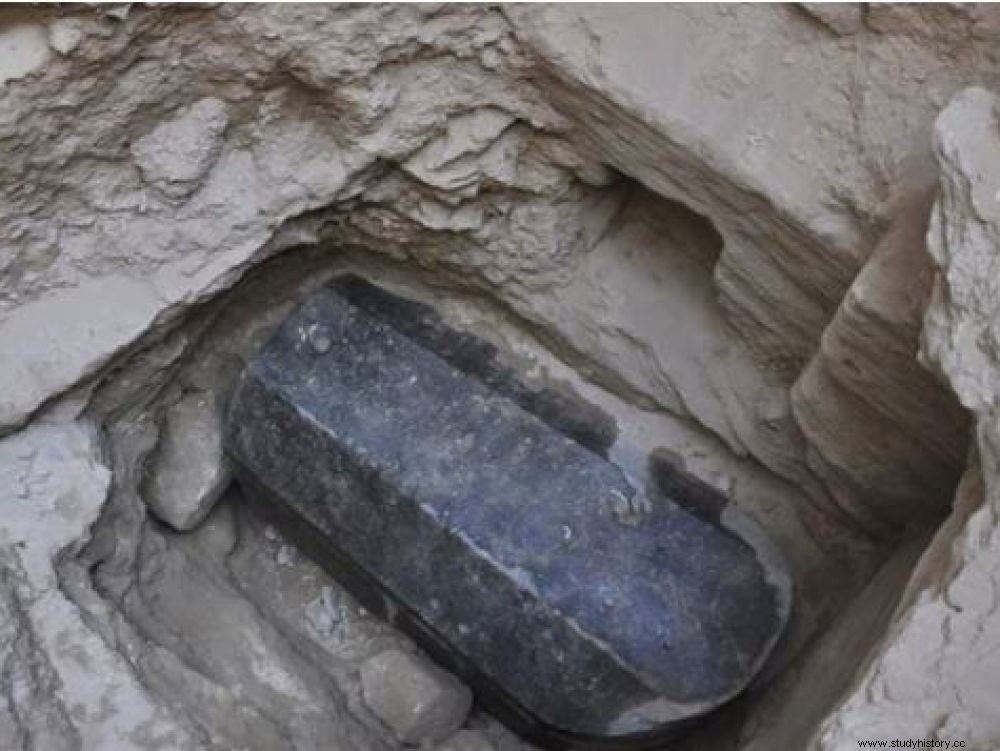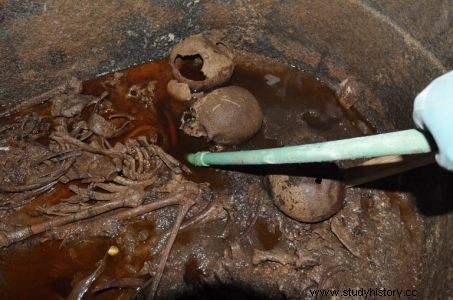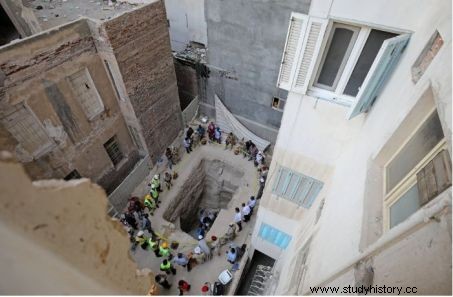The accidental discovery of an imposing black stone sarcophagus in the basements of the city of Alexandria, Egypt, recently set the web on fire... and for a few days people's minds. Its opening disappointed the expectations of those who hoped to find the remains of Alexander the Great there, which had not been found for 2,300 years.

The imposing granite sarcophagus discovered in early July 2018 in the city of Alexandria.
ANTIQUE. Alexandria…without Alexandra,…nor Alexander! Since the discovery, at the beginning of July 2018, by workers of an enormous sarcophagus of about thirty tons at 5 meters deep in the courtyard of the building of a residential district of the city with five million inhabitants, the The craziest speculations have continued to flourish on social networks. Could it be that we have finally found the tomb of Alexander the Great, the king of Macedonia who died in 323 BC? Faced with the media frenzy following this discovery, the Egyptian authorities decided to intervene. No, it's not the sarcophagus of Alexander (356-323 BC)!
Photo taken on July 19, 2018, at the time of the opening of the black sarcophagus. © AFP
After the opening of the monumental coffin on Thursday, July 19, 2018, Mostafa Waziri, secretary general of the Supreme Council of Egyptian Antiquities, said that the remains unearthed in the granite barrel were three in number, and that they probably belonged to soldiers. One of the skulls showed signs of fractures caused by a sharp instrument. Macabre detail, the skeletons bathed mainly in sewage infiltration. A reddish, foul-smelling liquid that some wanted to drink! On the web, an international petition of 15,000 signatures... demanded it! (Let's hope that was a big joke considering the consequences of ingesting "corpse juice" for a human being).
Discovery of the sarcophagus of Alexandria, 5 meters deep, in the courtyard of an apartment building. © Mohamed Abd El Ghany
“The granite sarcophagus was probably one of the tombs in the eastern cemetery of ancient Alexandria, where the Greeks and Macedonians of the Ptolemaic period were buried ”, could we read in the Cairo daily Egypt Today. The three figures would have been buried around 30 BC. Returning to the allegations linking this sarcophagus to Alexander the Great, Mostafa Waziri recalled that all known historical data located the burial of the powerful conqueror in the royal district in the center of the old city. “A district totally destroyed during the III th and IV e centuries following the revolutions and wars carried out by the population of the city ”, added the head of the Supreme Council of Antiquities. Alexander's last residence was at the intersection of the two main streets of the ancient city (read box below ). Sectors now fully urbanized, which have completely covered the ancient Greco-Roman city. It is therefore only thanks to construction work that windows sometimes open onto this vanished past, and that we gain access to the bowels of the city, as this tomb has just made it possible to do.
None of the three deceased was a member of a royal family
Alexandria Governor Mohamed Sultan told Egypt Today that the three skeletons would be transferred to the city's national museum. Mostafa Waziri, for his part, announced to the daily Arham online , that the sarcophagus was being studied for restoration, and that the liquid found inside would be examined to reveal its composition and nature, further clarifying that none of the three deceased belonged to a Ptolemaic royal family or Roman and that the coffin had no inscription or cartouche bearing any name.
Portrait of Alexander the Great (356-323 BC). © Ann Ronan Picture Library/Photo 12/AFP
Where did the mausoleum of Alexander go?
King at 19, master of the world at 28… What has become of the tomb of the greatest conqueror in history still remains an enigma. Died at the age of 32 in Babylon (located in present-day Iraq), on June 13, 323 BC, as he began his return to Greece, Alexander was buried in the city he had once founded in 331 BCE. Strabo indicates that it is in the royal district of the city that his hypogeum is located. What the hero of a Clytophon novel, in the II
th
century corroborates. In The Loves of Clytophon and Leucippus , a sentence describes the young man "passing at the intersection of the two main streets, at the corner of the tomb of Alexander ". History also confirms this presence. Diodorus of Sicily (I
st
century BC) and Lucan (I
st
century AD), thus describe Julius Caesar (100-44 BC) who came to bow over the tomb of Alexander, and Suetonius (126 AD), evokes Augustus (Octave ), placing a golden crown thereon. The same goes for the emperors Caligula (12-41 AD) and Caracalla (188-217). According to their descriptions, one could descend into the sepulcher where the "transparent" sarcophagus of Alexander was located... (made of glass? The use of this material was perfectly mastered at the time). Unfortunately, the neighborhood where this burial chamber resided has been ransacked several times. Moreover, after Caracalla, no official visit will ever be recorded. Archaeological excavations carried out in levels from the end of the III
th
century of this old sector already showed vestiges of abandoned houses, even victims of fires. Not to mention the tidal waves and earthquakes that the city had to endure. This district had become so unrecognizable that at the end of the IV
th
century, the Patriarch of Constantinople, St John Chrysostom (doctor of the Catholic Church 345 – 407) questioning his flock in a homily said:“Where is, tell me, the tomb of Alexander? Show it to me and tell me what day it died !” A way of remembering how fleeting glory is, and that the trace of the most revered heroes is also lost. No Alexandrian remembered the location of the last abode occupied by this true god. During the visit of the Emperor Augustus, when he was asked if, in addition to the great Alexander, he wanted to see the vaults of the Ptolemies, the Hellenistic dynasty descended from one of his generals, the Roman sovereign had these words:“No, I did not come to see corpses, but a man…” A legend that, in fact, is still more alive than ever.



